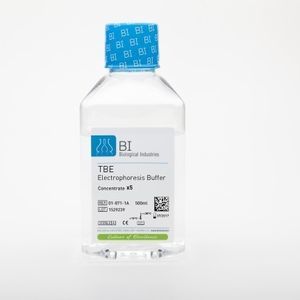
- Laboratory
- Laboratory medicine
- Buffer solution reagent
- Biological Industries
Buffer solution reagent 01-870-1Afor nucleic acidsfor electrophoresisliquid
Add to favorites
Compare this product
Characteristics
- Type
- buffer solution
- Applications
- for nucleic acids, for electrophoresis
- Format
- liquid
Description
TAE Buffer (50X) is a solution used in Agarose Gel Electrophoresis (AGE) typically for the separation of nucleic acids (i.e. DNA and RNA) and as a running buffer for preparative work. Tris-Acetate-EDTA (TAE) is not only used in nucleic acid agarose and polyacrylamide gel electrophoresis but also in agarose and polyacrylamide gel preparation.
Also described in the literature is TAE's role in denaturing gradient gel electrophoresis methods for broad-range analysis and at various concentrations and to study the mobility of DNA in solution with and without NaCl1.
DNA mobility on AGE is known to depend on the composition and strength of electrode buffer as well as the agarose concentrations. The resolution of super coiled DNA is better in TAE than TBE but TAE's buffering capacity is rather low as it tends to become exhausted during successive electrophoresis. TAE buffer is more useful for larger DNA fragments (<2.0kb) but TBE is more effective to obtain higher resolution of smaller DNA fragments (i.e. 300bp). Either buffer is adequate is applicable for middle-sized DNA fragments.
QTY - 500 mL
Storage Conditions - AMB
Shipping Conditions - Room Temperature
Instructions for Use -
Take a bottle of TAE Electrophoresis Buffer (50X) from specified storage conditions at 15-30°C and read the label.
Ensure that the cap of the bottle is tight.
Gently swirl the solution in the bottle to ensure homogeneity.
Wipe the outside of the bottle with a disinfectant solution such as 70% ethanol.
Catalogs
No catalogs are available for this product.
See all of Biological Industries‘s catalogsOther Biological Industries products
Molecular Biology Reagents
Related Searches
- Assay kit
- Solution reagent kit
- Molecular biology reagent kit
- Research reagent kit
- Diagnostic reagent kit
- Protein reagent kit
- Laboratory reagent kit
- Enzyme reagent kit
- Histology reagent kit
- Reagent medium reagent kit
- Cytology reagent kit
- Buffer solution reagent kit
- Clinical reagent kit
- Blood sample reagent kit
- Laboratory detection kit
- Cell assay kit
- Tissue reagent kit
- Nucleic acid reagent kit
- Serum reagent kit
- Electrolyte reagent kit
*Prices are pre-tax. They exclude delivery charges and customs duties and do not include additional charges for installation or activation options. Prices are indicative only and may vary by country, with changes to the cost of raw materials and exchange rates.



